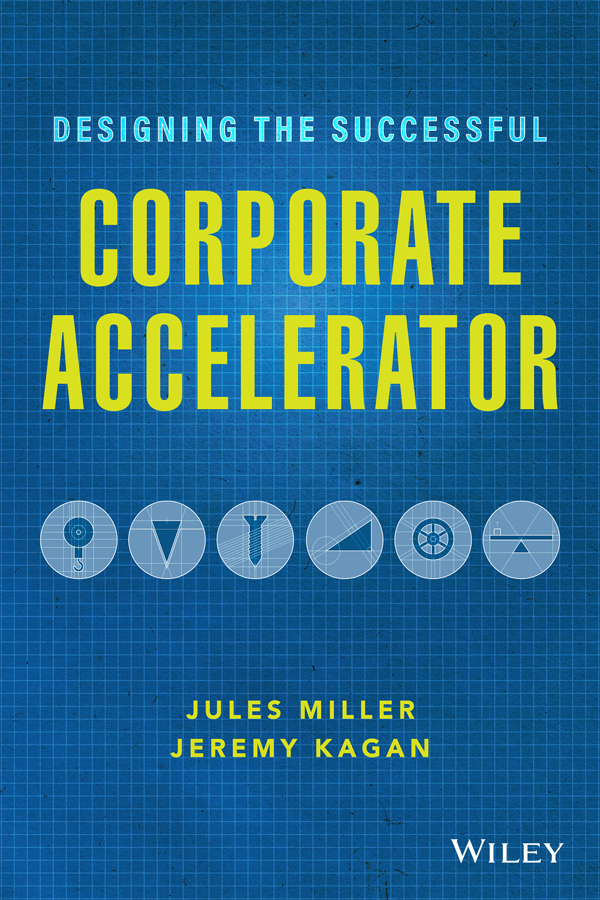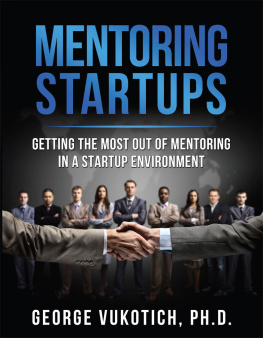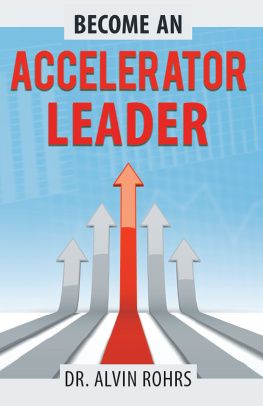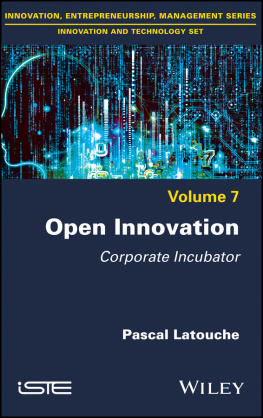
Table of Contents
Guide
Pages
Designing the Successful Corporate Accelerator
Jules Miller
Jeremy Kagan

Cover Design and Images: Ewelina Olechowska
Copyright 2021 by John Wiley & Sons, Inc. All rights reserved.
Published by John Wiley & Sons, Inc., Hoboken, New Jersey.
Published simultaneously in Canada.
No part of this publication may be reproduced, stored in a retrieval system, or transmitted in any form or by any means, electronic, mechanical, photocopying, recording, scanning, or otherwise, except as permitted under Section 107 or 108 of the 1976 United States Copyright Act, without either the prior written permission of the Publisher, or authorization through payment of the appropriate per-copy fee to the Copyright Clearance Center, Inc., 222 Rosewood Drive, Danvers, MA 01923, (978) 750-8400, fax (978) 646-8600, or on the Web at www.copyright.com. Requests to the Publisher for permission should be addressed to the Permissions Department, John Wiley & Sons, Inc., 111 River Street, Hoboken, NJ 07030, (201) 748-6011, fax (201) 748-6008, or online at www.wiley.com/go/permissions.
Limit of Liability/Disclaimer of Warranty: While the publisher and author have used their best efforts in preparing this book, they make no representations or warranties with respect to the accuracy or completeness of the contents of this book and specifically disclaim any implied warranties of merchantability or fitness for a particular purpose. No warranty may be created or extended by sales representatives or written sales materials. The advice and strategies contained herein may not be suitable for your situation. You should consult with a professional where appropriate. Neither the publisher nor author shall be liable for any loss of profit or any other commercial damages, including but not limited to special, incidental, consequential, or other damages.
For general information on our other products and services or for technical support, please contact our Customer Care Department within the United States at (800) 762-2974, outside the United States at (317) 572-3993, or fax (317) 572-4002.
Wiley publishes in a variety of print and electronic formats and by print-on-demand. Some material included with standard print versions of this book may not be included in e-books or in print-on-demand. If this book refers to media such as a CD or DVD that is not included in the version you purchased, you may download this material at http://booksupport.wiley.com. For more information about Wiley products, visit www.wiley.com.
Library of Congress Cataloging-in-Publication Data:
Names: Miller, Jules (Advisor to enterprise startups) author. | Kagan, Jeremy (Growth and innovation consultant) author.
Title: Designing the successful corporate accelerator : how startups and big companies can get with the program / Jules Miller, Jeremy Kagan.
Description: First edition. | Hoboken : Wiley, 2021. | Includes index.
Identifiers: LCCN 2020056295 (print) | LCCN 2020056296 (ebook) | ISBN 9781119709060 (cloth) | ISBN 9781119709084 (adobe pdf) | ISBN 9781119709053 (epub)
Subjects: LCSH: New business enterprises. | Corporations. | Technological innovationsManagement.
Classification: LCC HD62.5 .M545 2021 (print) | LCC HD62.5 (ebook) | DDC 658.4/063dc23
LC record available at https://lccn.loc.gov/2020056295
LC ebook record available at https://lccn.loc.gov/2020056296
This book is dedicated to all the innovators, disruptors, change agents, and intrapreneurs who are working hard to innovate from within your companies. It's often a thankless job as you try to move mountains with only your bare hands and sheer willpower. We've been there and feel your pain. We hope this book helps you, at minimum, with another supporting hand to move those mountains. We know you can make it happen!
Foreword
Finding your way through any unfamiliar jungle is always easier with Google or (gasp) even paper maps. That's why this book is so important it's the map big corporations need to uncover a disruptive innovation powerhouse inside their own companies. Designing the Successful Corporate Accelerator first challenges whether you have the right pieces in place to set up an accelerator at all, and if you do, it helps you navigate the road to success along every step of the way. For the best results, consider sharing this book generously with your leadership team and everyone involved in the innovation process.
Successful disruptive innovation is a war that big corporations have been losing for generations. With your determination and the authors guidance, perhaps the next decade can be the turning point where companies actually get it right. What the heck, it's only been 75 years since we lost Henry Ford, and 90 for Thomas Edison, right?
Over the past century, large companies poured billions of dollars into allegedly disruptive failures with an embarrassing success rate well below 10%. Remember Edsel, Saturn, Betamax, and New Coke? They're just a whisper of the cast of fallen characters. Each is incrementally innovative, for sure, but all are simply old solutions with a few new bells and whistles.
And, as the authors discuss, many corporations excel at innovation theater: putting young people in cool tech-forward office space with foosball and ping pong plus a dozen exotic flavors of fresh-ground coffee. Seldom have these theaters produced any meaningful disruptive innovation, the kind that changes lives, markets, or the way we do things. You know, things like self-driving or electric cars, hydrogen fuel cells, iPhones, or even Amazon.com. It's fundamentally different, far more intense innovation, writ large.
Most of the time, truly disruptive innovation is the province of startups many founded in the proverbial garages like trailblazers Apple and HP. These smaller, more nimble companies usually led and nearly always staffed by T-shirted, scruffy 20- to 30-year-olds consistently deliver the lion's share of disruptive innovations that continuously change our universe. Startups aren't shackled by the constraints or bureaucracy of the dinosaur corporations, which allows them to be creative and try things that bigger companies can't (or won't). And they do it at a blistering speed.
In 1973, when I last worked at a Fortune 1000 company before joining the entrepreneur and venture capital world, I mostly worked the 2:309:30 a.m. shift, editing news for Westinghouse Broadcasting. Apple, Microsoft, Oracle, and SAP were born at this time. Tesla, Uber, and others followed in a nonstop recurring pattern readily summarized as startups innovate, corporations execute. And for the past 50 years or so, with a few notable exceptions, truly disruptive innovation has been seen as antithetical to the common wisdom practiced by the world's leading corporations. No skateboards, risk-taking or failures in these hallowed halls, sonny! is the mantra. Corporate managers plan, then execute the plan, and the corporation executes those who don't execute. See, it's simple. But how?
Risk-taking that leads to disruptive innovation is just so much easier in a startup. Unlike corporations, startups basically have nothing to lose no customers to screw up, no reputation to sully, and no rulebook or procedures manual to follow religiously. Most corporate executives described startup operations as chaos theory in action there was no formal process, no roadmap to guide the innovation process. Then in 1999 Steve Blank retired after the $8 billion IPO of E.piphany, the company he founded three years prior, and decided to teach and write down what he'd learned in a career spanning a dozen startups.
Next page








